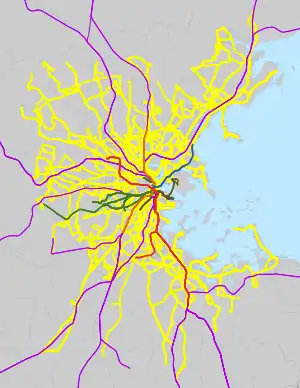MBTA bus
The Massachusetts Bay Transportation Authority operates 170 bus routes (list of routes) in the Greater Boston area, many of which were formerly part of a large streetcar system. Some routes are for local transport within the city; others bring passengers from surrounding areas to stops on the MBTA Commuter Rail or subway lines. The MBTA has a policy objective to provide transit service within walking distance (defined as 0.25 miles (0.40 km)) for all residents living in areas with population densities greater than 5,000 inhabitants per square mile (1,900/km2) within the MBTA's service district. Much of this service is provided by bus.
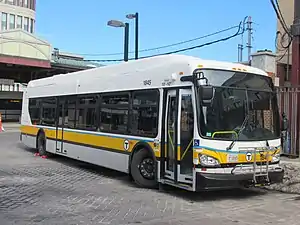 A New Flyer XDE40 bus at Dudley station in 2017 | |||
| Parent | Massachusetts Bay Transportation Authority | ||
|---|---|---|---|
| Founded | 1964 (predecessors date to 1856) | ||
| Locale | Greater Boston | ||
| Service area | Boston and immediate suburbs | ||
| Service type | Local, limited stop, express, and Silver Line BRT | ||
| Routes | 170[1] | ||
| Fleet | 1139 (Active)[1] | ||
| Daily ridership | 387,815 (2013)[2] | ||
| Fuel type | Diesel, CNG, electric trolleybus, diesel-electric hybrid | ||
| Operator | MBTA; private operators | ||
| Website | mbta.com | ||
| |||
The MBTA operates a five-route bus rapid transit service branded as the Silver Line, as well as two crosstown routes that were intended to become the first part of the now-suspended Urban Ring project. Fifteen routes designed as key routes run with higher frequency at all times.
Most MBTA bus service is served by diesel, compressed natural gas, and diesel-electric hybrid buses. Silver Line routes running in the Waterfront tunnel use dual-mode buses that operate as trolleybuses in the tunnel and as diesel buses on the surface. Four routes based out of the Harvard bus tunnel run with trolleybuses in Cambridge and several surrounding suburbs.
All buses and routes are accessible (see MBTA accessibility); the entire bus fleet consists of low-floor buses with fold-out ramps. All buses have LED exterior headsigns displaying route and destination, with automated audio/visual stop announcements for passengers.
History
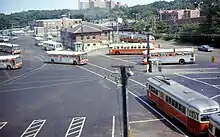
After taking over operations in August 1964 from the former Metropolitan Transit Authority, the MBTA began rebranding many elements of Boston's public transportation network. After being found unsuitable in 1965 for what is now the Orange Line because it did not show up well on maps, yellow was chosen for the color of bus operations on January 8, 1972.[3][4]
The Boston Elevated Railway and MTA operated overnight Owl service until 1960. From September 2001 to June 2005, the MBTA operated bus service on 17 routes (7 normal bus routes and 10 routes replicating subway lines) until 2:30am on Friday and Saturday nights. Similar service on the key routes was operated from March 2013 to March 2014.[5] In 2017, the MBTA Board considered a proposal to run all-night service on several routes with pulsed connections at a central hub.[6]
Fleet
Active fleet
This is the current bus roster for the MBTA as of February 2021. All buses are 102 inches (260 cm) wide; most buses are 40-foot (12 m) length, while 107 are 60-foot (18 m) articulated buses.[1]
| Order Year | Manufacturer | Model | Picture | Fleet | Qty. | Active | Propulsion | Length (ft.) | Notes |
|---|---|---|---|---|---|---|---|---|---|
| 2004 | Neoplan USA | AN440LF |  |
4101–4128 | 28 | 28 | Electric trolleybus | 40 |
|
| 2004–2005 | Neoplan USA | AN440LF | %252C_March_2017.jpg.webp) |
0401–0593 | 111 | 75 | Diesel | 40 |
|
| 2004–2005 | Neoplan USA | DMA-460LF |  |
1101–1132 | 32 | 32 | Dual mode | 60 |
|
| 2006–2007 | NFI | D40LF |  |
0600–0754 | 153 | 151 | Diesel | 40 | |
| 2008 | NFI | D40LF |  |
0756–0910 | 155 | 155 | Diesel | 40 |
|
| 2010 | NFI | DE60LFR |  |
1200–1224 | 25 | 25 | Hybrid | 60 |
|
| 2014–2015 | NFI | XDE40 |  |
1400–1459 | 60 | 60 | Hybrid | 40 | |
| 2016–2017 | NFI | XN40 |  |
1600–1774 | 175 | 175 | CNG | 40 | |
| 2016–2017 | NFI | XDE40 |  |
1775–1924 & 3000–3005 |
156 | 156 | Hybrid | 40 | |
| 2016–2017 | NFI | XDE60 |  |
1250–1293 | 44 | 44 | Hybrid | 60 |
|
| 2018 | NFI | XDE60 |  |
1294 | 1 | 1 | Hybrid | 60 |
|
| 2019 | NFI | XE60 |  |
1295–1299 | 5 | 5 | Battery-electric | 60 |
|
| 2019–2020 | NFI | XDE40 | 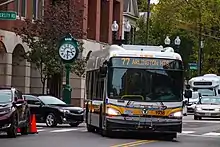 |
1925–2118 | 194 | 194 | Hybrid | 40 | |
| 2020 | NFI | XDE40 | 3100–3159 | 60 | 57 | Hybrid | 40 |
|
Future
In November 2020, the MBTA exercised a contract option for 45 additional 60-foot hybrid buses with extended battery range (similar to test bus #1294) to replace the dual-mode Silver Line fleet. The buses will be delivered in 2022.[10]
The MBTA may begin a phased 500-bus order in 2021, with delivery from 2022–2026. Under that plan, the agency would establish a continuous procurement process with 100 new buses per year, and buses retired after 12 years.[1]
Facilities

|
Albany
Arborway
Cabot
Charlestown
Fellsway
Lynn |
North Cambridge
Quincy
Somerville
Southampton
Private carriers |
MBTA buses are operated out of nine facilities.[1] The MBTA plans to replace Quincy Garage with a larger facility near Quincy Adams station.[11]
| Name | Address | Routes | Times of Operation |
|---|---|---|---|
| Albany Street | 421 Albany Street, Boston | 4, 55, 57, 59, 60, 65, 170, 501, 502, 503, 504, 505, 553, 554, 556, 558, CT2, CT3 | Weekday rush hours and middays |
| Arborway | 3600 Washington Street, Jamaica Plain | 14, 21, 24, 26, 27, 29, 30, 31, 32, 33, 34, 34E, 35, 36, 37, 38, 39 (evenings), 40, 41, 42, 50, 51, 52 | Full-time |
| Cabot | 275 Dorchester Avenue, South Boston | 1, 7, 8, 9, 10, 11, 15, 16, 17, 18, 19, 22, 23, 43, 44, 45, 47, 66, 171 Also serves routes 55, 57, 59, 65, 504, and 553 when Albany Street is closed |
Full-time |
| Charlestown / Bennett (Somerville) | 21 Arlington Avenue, Charlestown | 61, 62, 64, 67, 68, 69, 70, 71, 72, 73, 74, 75, 76, 77, 78, 79, 80, 83, 84, 85, 86, 87, 88, 89, 91, 92, 93, 101, 104, 109, 110, 111, 112, 325, 326, 350, 351, 352 Also serves routes 90, 94, 95, 96, 97, 99, 100, 105, 106, 108, 132, 134, 136, 137, 411, and 430 when Fellsway Garage is closed, and routes 71 and 73 on Sundays |
Full-time |
| Fellsway | 465 Salem Street, Medford | 90, 94, 95, 96, 97, 99, 100, 105, 106, 108, 131, 132, 134, 136, 137, 354, 411, 430 | Weekday rush hours and middays |
| Lynn | 985 Western Avenue, Lynn | 114, 116, 117, 119, 120, 121, 424, 426, 428, 429, 434, 435, 436, 439, 441, 442, 450, 451, 455, 456, 465 | Full-time |
| North Cambridge | 2375 Massachusetts Avenue, Cambridge | 71, 73, 77A | Weekdays and Saturdays |
| Quincy | 954 Hancock Street, Quincy | 201, 202, 210, 211, 212, 214, 215, 216, 217, 220, 221, 222, 225, 226, 230, 236, 238, 240, 245 | Full-time |
| Southampton | 230 Southampton Street, Boston | 28, 39, Silver Line | Full-time |
Private buses

Most local bus routes in Massachusetts outside the immediate MBTA operating area are operated by the state's other regional transit authorities (RTAs). However, some routes that connect with MBTA bus or subway service are operated by outside private contractors with partial subsidy by the MBTA. [12]
Five routes – the 710, 712/713, 714, and 716 – are numbered like other MBTA buses. The five routes are primarily commuter routes which connect with other MBTA services at their inbound terminals. They were taken over from various private operators (Hudson Bus Lines for the 710 and 716, Rapid Transit Inc. for the 712/713, and Nantasket Transportation for the 714).[5] The 712 and 713 use MBTA-provided buses and accept Charliecards; the other routes do not.
Four suburban municipalities contract with outside operators for local circulator routes, most with partial MBTA subsidy. Bedford and Beverly run single routes, Burlington runs five routes, and Lexington runs six.[5] Most are run by private operators, except for the Beverly Shuttle, which is part of the Cape Ann Transportation Authority system. Additionally, a nonprofit shuttle is run in Boston's Mission Hill neighborhood.[5] Those routes appear on MBTA system maps and connect with MBTA services at designated transfer points, but are numbered separately and do not accept MBTA passes.
Bus lanes
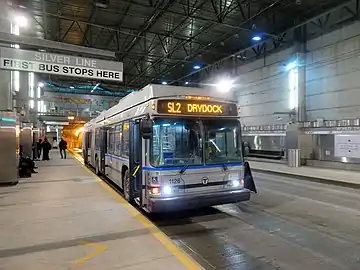
Several sections of dedicated right-of-way for MBTA buses have been opened in the 21st century. Two sections of the Silver Line have off-street busways: The 2004-opened 1.2-mile (1.9 km) South Boston Piers Transitway tunnel in the Seaport (used by the SL1, SL2, SL3, and SLW), and a 2018-opened 1.1-mile (1.8 km) surface busway in Chelsea used by the SL3. A direct ramp to the Ted Williams Tunnel is proposed for use by the SL1 and SL3.
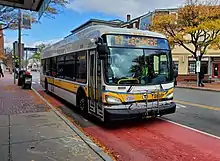
A number of dedicated bus lanes on surface streets are also in use:
- Washington Street, Boston:
- 1.6 miles (2.6 km) between Melnea Cass Boulevard and Kneeland Street (including a short southbound contraflow section), with an additional 0.3 miles (0.48 km) northbound-only between Stuart Street and Temple Place. The lanes are used by Silver Line routes SL4 and SL5, as well as local routes 8, 10, and 11. The southern section was opened in 2002 with the introduction of Silver Line service; the portion north of Herald Street (northbound) and Marginal Street (southbound) was added in mid-2020 along with a lane on Temple Place.[13]
- 0.9 miles (1.4 km) of northbound morning-peak-only bus/bike lane between Roslindale and Forest Hills was added in June 2018 following a test that May. The section is used by routes 30, 34, 34E, 35, 36, 37, 40, 50, and 51.[14]
- Essex Street, Boston: Two eastbound segments totaling 0.2 miles (0.32 km), opened in 2009 for use by the SL4.[15]
- Broadway, Sweetser Circle, and Main Street, Everett: A 1.1-mile (1.8 km) morning-peak-only southbound bus lane on Broadway from Henry Street to Sweetser Circle (routes 97, 104, 109, 110, 112) was opened in 2017 after a 2016 test.[16] A 0.4-mile (0.64 km) northbound evening-peak-only lane on Broadway from Sweetser Circle to Chelsea Street, a 0.15-mile (0.24 km) northbound evening-peak-only lane on Main Street from Sweetser Circle to Oakes Street (routes 99, 105, 106), and an all-day lane around Sweetser Circle were added in October 2020.[17][18]
- Prospect Street, Somerville: a 0.1-mile (0.16 km) northbound bus/bike lane (routes91, CT2) opened in 2017.[19]
- Mount Auburn Street and Belmont Avenue, Cambridge and Watertown: Three segments totaling 0.6 miles (0.97 km), installed in October 2018 for routes 71 and 73.[20]
- Massachusetts Avenue, Cambridge: 0.5 miles (0.80 km) of southbound bus lane from Sidney Street to Memorial Drive for route 1, opened in November 2018.[21]
- Sullivan Square, Boston: Three short sections of bus-only turn lane on Beacham Street (routes 86, 91, CT2), Maffa Way (89, 90, 95, 101), and Main Street (92, 93, 104, 105, 109) for buses entering Sullivan Square station, installed as part of a 2018–2019 reconfiguration of the station.[22]
- Brighton Avenue, Boston: 0.6 miles (0.97 km) of bus/bike lanes between Commonwealth Avenue (Packards Corner) and Union Square, used by routes 57, 57A, and 66. The eastbound lane was opened in June 2019, followed by the westbound lane that October.[23]
- Broadway, Somerville: 0.9 miles (1.4 km) of bus/bike lanes between Magoun Square and Fellsway West for routes 89 and 101, opened in August 2019.[23]
- North Washington Street, Boston: 0.15 miles (0.24 km) of southbound bus/bike lane (route 92, 93, 111, 426, and 428) from Causeway Street to Beverly Street opened in August 2019.[23]
- Summer Street, Boston: 0.14 miles (0.23 km) of westbound bus lane between Dorchester Avenue and Atlantic Avenue for routes 4 and 7, opened in October 2019.[23]
- Massachusetts Avenue, Arlington: 0.3 miles (0.48 km) of southbound morning-peak-only bus/bike lane from Varnum Street to Alewife Brook Parkway for route 77. This lane was installed in October 2019 after a successful test a year before.[24]
- Charles River Dam Bridge and Nashua Street, Boston and Cambridge: 0.7 miles (1.1 km) of bus lanes between North Station and Lechmere for use by shuttle buses during Green Line Extension construction. The lanes were opened in May 2020 when the shuttles began operation, and will be closed in 2021 when the Extension opens.[23]
- Davis Square, Somerville: queue jumps on Holland Street (routes 87 and 88) and College Avenue (89, 94, 96) opened in 2020.[19]
- Broadway, Chelsea: a 0.2-mile (0.32 km) westbound bus lane from 5th Street to 3rd Street for routes 111, 114, 116, and 117 opened in November 2020.[25]
- Tobin Memorial Bridge: 1.1 miles (1.8 km) of westbound bus lane for route 111 (a 12-month pilot) opened in December 2020.[26]
- Florence Street, Malden: a 0.2-mile (0.32 km) westbound bus/bike lane opened in December 2020.[27]

Additional lanes are planned in 2020–2021:[28]
- Columbus Avenue, Boston: 0.7 miles (1.1 km) of center-running lanes between Walnut Street and Jackson Square (routes 22, 29, 44) began construction in October 2020.[29] An additional 1.0 mile (1.6 km) on Columbus Avenue and Tremont Street between Jackson Square and Ruggles (routes 15, 22, 23, 28, 44, 45) is planned.
- North Washington Street, Boston: 0.15 miles (0.24 km) of northbound bus/bike lane (routes 92, 93, 111) from Cross Street to Causeway Street
- Washington Street, Boston: 1.5 miles (2.4 km) of southbound evening-peak-only bus/bike lane from Forest Hills to Roslindale
- Malcolm X Boulevard, Boston: 0.5 miles (0.80 km) of bus lanes between Roxbury Crossing and Nubian Square (routes 14, 15, 23, 28, 41, 44, 45, 66)
- Warren Street, Boston: 1.3 miles (2.1 km) of bus lanes between Nubian Square and Grove Hall (routes 14, 19, 23, 28, 44)
- Hyde Park Avenue, Boston: 2.1 miles (3.4 km) of bus lanes between Forest Hills and Metropolitan Avenue (routes 14 and 32)
- Washington Street, Somerville: bus/bike queue jumps between McGrath Highway and Sullivan Square, and between Beacon Street and Union Square[19][23]
- Mystic Avenue, Somerville and Medford: a morning-peak-only southbound bus lane (route 95)[19]
Center-running bus lanes are proposed for Summer Street in the Seaport (routes 4, 7, 11) and Blue Hill Avenue between Grove Hall and Mattapan (routes 14, 22, 28, 29, 31, 45).[30][31]
References
- "MBTA Vehicle Inventory". NETransit. Retrieved November 14, 2019.
- "Ridership and Service Statistics" (PDF) (14th ed.). Massachusetts Bay Transportation Authority. 2014.
- Tran, Andrew Ba (June 2012). "MBTA Orange Line's 111th anniversary". Boston Globe. p. 11. Archived from the original on July 21, 2017.
- A Chronicle of the Boston Transit System. Massachusetts Bay Transportation Authority. 1981. p. 8 – via Internet Archive.
- Belcher, Jonathan. "Changes to Transit Service in the MBTA district" (PDF). NETransit.
- Vaccaro, Adam (August 1, 2017). "MBTA may test overnight buses, Foxborough commuter rail". Boston Globe.
- "Baker-Polito Administration, State and Transportation Officials Celebrate the MBTA's First Extended-range Hybrid Bus in the MBTA Silver Line Fleet" (Press release). Massachusetts Department of Transportation. September 26, 2018.
- "First Zero-emission, Battery-electric Buses Join the MBTA Silver Line Fleet" (Press release). Massachusetts Bay Transportation Authority. July 31, 2019.
- "Low or No Emission Vehicle Deployment Program Project Selections". Federal Transit Administration. February 5, 2015.
- Wolfgang, Bill (November 23, 2020). "Silver Line Bus Fleet Replacement" (PDF). Massachusetts Bay Transportation Authority.
- "MBTA Bus Facility Modernization Program: New Quincy Maintenance Facility" (PDF). Massachusetts Bay Transportation Authority. January 29, 2020.
- "Private Bus". Massachusetts Bay Transportation Authority. Retrieved 22 July 2014.
- "New Bus and Bike Lanes Established on Washington Street in Downtown Boston and Chinatown To Improve Silver Line and Traffic Safety" (Press release). Massachusetts Bay Transportation Authority. July 6, 2020.
- "PERMANENT BUS LANE TO BE ESTABLISHED ON WASHINGTON STREET IN ROSLINDALE" (Press release). City of Boston Transportation Department. June 7, 2018.
- "PATRICK-MURRAY ADMINISTRATION, MAYOR MENINO LAUNCH SILVER LINE DIRECT CONNECT SERVICE TO SOUTH STATION" (Press release). Massachusetts Bay Transportation Authority. October 13, 2009.
- Mohl, Bruce (September 17, 2018). "Bus lane: Everett just did it". CommonWealth Magazine.
- "Groundbreaking for Network of Bus Lanes in Everett to Improve Transit for Nearly Ten Thousand Riders" (Press release). Massachusetts Bay Transportation Authority. September 25, 2020.
- Vaccaro, Adam (October 30, 2020). "A once-chaotic rotary gets a bus lane". Boston Globe.
- "COVID-19 Mobility Response: Quick-Build Bus Lanes". City of Somerville.
- "Mt. Auburn Street Bus Priority Pilot". Cambridge Community Development Department. 2020.
- Annear, Steve (November 29, 2018). "'Big change' for bikes, buses comes to Mass. Ave. in Cambridge". Boston Globe.
- "Sullivan Square Busway and Parking Lot Reconstruction". Massachusetts Bay Transportation Authority. 2019.
- "Bus Transit Priority". Massachusetts Bay Transportation Authority. Retrieved November 24, 2020.
- "Priority Bus Lane Is Now Operational" (Press release). Town of Arlington, Massachusetts. October 24, 2019.
- "First MBTA Bus Lane on Broadway in Chelsea will Improve Commutes for Thousands of Riders and Essential Workers" (Press release). Massachusetts Bay Transportation Authority. November 12, 2020.
- "MBTA and MassDOT Announce Tobin Bridge Bus Lane Pilot" (Press release). Massachusetts Bay Transportation Authority. December 8, 2020.
- "MassDOT, MBTA, and City of Malden Collaborate to Implement New Bus Lanes, Bus Network, and Roadway Safety Improvements through Shared Streets & Spaces Program" (Press release). Massachusetts Bay Transportation Authority. December 10, 2020.
- "MBTA and Cities of Boston, Somerville, Everett, Chelsea to Rapidly Construct 14 Miles of Bus Lanes in Unprecedented Regional Effort to Improve Public Health, Transit Reliability, Multimodal Access in the Wake of COVID-19" (Press release). Massachusetts Bay Transportation Authority.
- "Work Begins on Columbus Avenue" (Press release). Massachusetts Bay Transportation Authority. October 23, 2020.
- Vaccaro, Adam (September 27, 2020). "The federal government rejected funding for a major Blue Hill Avenue bus project. Now what?". Boston Globe.
- Vaccaro, Adam; Logan, Tim (August 28, 2020). "Who should own the road in the Seaport, trucks or buses?". Boston Globe.
External links
| Wikimedia Commons has media related to MBTA Bus. |
